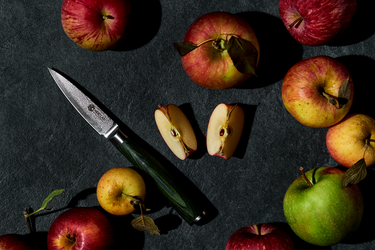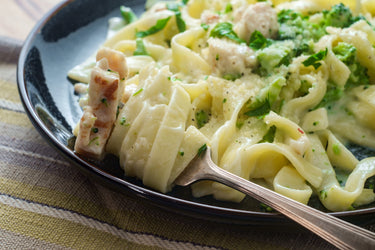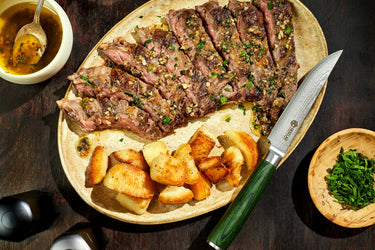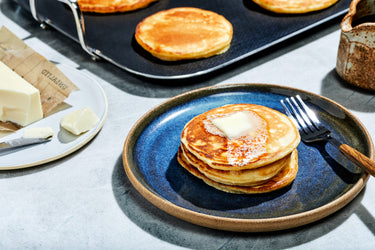Damascus Steel: Everything You Need To Know

We need to talk about what’s in your drawers.
Your kitchen drawers — specifically your knives. Chances are you were searching for Damascus steel cutlery because you aren’t totally satisfied with what lives in your butcher block at the moment.
If that’s the case, it’s time to upgrade your arsenal. Good thing you have Hexclad, because we’ve got the ultimate Japanese Damascus Steel knives.
What Is Damascus Steel?
Damascus steel knives are the best knives that money can buy! However, to fully appreciate these blades and use them well, it’s essential to understand their finer points.
Where Does Damascus Steel Get Its Name?
There are two sources to which we can trace the name Damascus. They are two scholars from the Middle East: Al-Kindi and Al-Biruni.
Both scholars wrote about steel and the forging process of swords from different parts of the world, as well as their distinct appearances. With this information in mind, there are three possible avenues that got us where we are with true Damascus steel.
- Damascene: Al-Kindi described the sword-making process in Siberia and the swords forged in steel as Damascene.
- Damasqui: Al-Biruni wrote of a sword-smith named Damasqui whose swords were made of crucible steel.
- Damas: In Arabic, the term damas translates to “watered.” This could reference the fact that a Damascus steel blade is said to have a water-like pattern on the outside.
What Is Wootz Steel?
The process of forging Damascus steel originated in India over 2,000 years ago. It was made from steel known as wootz.
Damascus swords and other weapons created from this steel reached their height of popularity around the 4th century in Damascus, in what is now known as modern Syria.
How Damascus Steel Evolved
While kitchen knives today may be considered modern Damascus steel, the original Damascus steel process was lost in the 1700s.
Back in that century, a bladesmith viewed knife making as an art, fashioning steel ingots and other raw materials into high-quality blades. This process required working in unbearably high temperatures to remove the impurities from the steel. However, the loss of Damascus steel technically came from a change in the material that was being mined, not any technique from a swordsmith.
Today, we’re bringing Damascus steel back to its badass roots with carefully-forged blades that cut through ingredients like a Samurai sword.
What Is San-Mai Steel?
Currently, most steel is made using either a pattern welded or San-Mai process.
Pattern welded Damascus blades go through a process of folding the metal on top of one another to create a wave pattern. Once formed, these blades undergo a chemical process that creates the wave-like surface pattern. This process is sometimes called billet welding by metallurgists.
For a San-Mai blade, layers of stainless steel are forged together with a stainless steel or high carbon steel core. This is the process used to create Damascus steel today.
When looking for these knives, steer clear of Damascus patterns that are etched into the blade. These are probably not authentic Damascus steel blades — but are still sold for the same price. Don’t get scammed.
Choosing the Right Steel
Most blacksmiths utilize roughly two to five metal alloys or types of steel to create a robust, beautifully made blade.
These alloys are usually high in carbon content, and the carbides make the high-end steel extra durable. Once the blade has been welded and shaped, you can alter the blade's appearance and edge through different processes, such as the heat treatment process.
When To Hone Your Damascus Steel Knife
Honing a knife brings the edge of the blade back to the center. With typical wear and tear on a knife the edge of the blade can start to miss its mark.
Many at-home and professional chefs hone their knives before each use to make the blades as effective as possible at trimming meats or cutting veggies, making a honing tool an essential instrument to keep in your kitchen. Once you learn the proper motion for honing a knife, you’ll want to make it routine.
When To Sharpen Your Damascus Steel Knife
Sharpening a knife is different from honing, although it’s easy to confuse the two. With honing, you’re bringing the edge of the knife back to its center. When you’re sharpening a knife, you’re creating a new edge.
As a general rule of thumb, you’ll hone a knife regularly, either with every use or at least as a monthly habit. On the other hand, you’ll want to aim for a schedule that leaves about six to 12 months between sharpening sessions.
Using a dulled blade can cause huge issues with your cutting techniques and it increases the risk of hurting yourself. A dull knife will slip on the surface of food, but it’ll still be sharp enough to cut your hand. Play it safe and sharpen your knives regularly.
Sharpening is an essential skill that every serious chef needs to know. You can buy small machines that allow you to sharpen knives, but it’s generally better to perform this task by hand.
In addition, there are chef’s shops that will sharpen your knives if you bring them in. You may also be able to find someone that will come to your home and sharpen your blades every few months.
Choosing the Right Cutting Board To Go With Damascus Steel
While you can use any size or type of cutting board, the best option for keeping your knives sharp will always be a wooden cutting board.
A lot of controversy surrounds the topic of wooden cutting boards because many people feel they can’t be properly cleaned. However, this isn’t the case. Ultimately, all it takes to keep a wooden cutting board clean is scrubbing the surface with soap and water right after use.
The biggest thing to remember about wooden cutting boards is that you can use them to cut meats, but you must clean them with warm water and soap immediately. That way, you’ll avoid spreading bacteria around your kitchen.
Comparing Damascus Steel Knife Quality
Ensuring the quality of your Damascus steel knife is essential because fakes are often sold for the same price.
You’ll want to look for descriptions that include pattern welded or VG-10, which refers to the San-Mai process of creating the blades.
Knives that feature an etch pattern aren’t legit, but companies still try to pass them off as the real deal. They’re generally easy to spot, and the pattern won’t be consistent throughout, so look for this cue if you can’t tell whether a knife is authentic.
What Are the Essential Japanese Damascus Steel Knives?
There are quite a few knives made from Japanese Damascus steel and you’ll want to know the names of each to understand what you’ll need and want for your personal use.
- Gyuto or Chef’s Knife: You need these in your kitchen because it will provide the most versatility and will never let you down.
- Santoku or Multipurpose Knife: This is a workhorse in knife form and another must-have. It will help with heavy-duty cutting and butchering in a slightly smaller frame than the Gyuto.
- Bnka: Another multipurpose knife: This blade performs similar functions to the Santoku but is not as traditional.
- Nakiri/Usuba or Vegetable knife: It’s not as necessary to have in the kitchen, but if you’ve invested in a solid set of knives, the set will come with a Nakiri. It’s perfect for vegetables since it’s a shorter blade and handles well for quick dicing and slicing.
- Petty or Paring knife: This is a must-have in a strong set of Japanese steel knives. It performs small tasks with the most precision. While a chef’s knife provides the most versatility there are jobs it just isn’t suited for and that’s where your paring knife comes in.
Why Choose HexClad Damascus Steel Knives?
It can be overwhelming having to decide which knife you can’t live without. That’s why we offer a 6PC Essential Set of Damascus Steel Knives. These are the only knives you’ll ever need for food prep.
You get all of the traditional Japanese knives and a honing tool included in the set. These knives will stay sharp and centered for as long as you’re cooking.
We’re serious about our craft and it shows when you handle these blades. We use 67 layers of stainless Damascus steel to create our knives, which also have a rating of 60 on the Rockwell scale. This is the real deal!
Knives Are Essential in the Kitchen
Knives are essential to any home chef’s kitchen setup and they can be legitimately dangerous when handled wrong. Luckily, you’ve got all the information you need to pick the right Damascus steel knives and use them the way they’re designed.
Our complete knife set will have you cooking for years to come, trimming and dicing with ease.
Sources:
The Mystery of Damascus Steel Appears Solved | The New York Times





